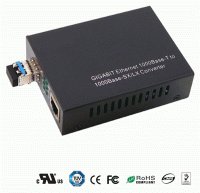Fiber Optic Media Convertor

The most common type of media converter is a device that functions as a transceiver; converting the electrical signal used in copper Unshielded Twisted Pair (UTP) network cabling into light waves used in fiber optic cabling. Fiber optic connectivity is necessary when the distance between two network devices exceeds the transmission distance of copper cabling. Copper-to-fiber conversion using media converters enables two network devices with copper ports to be connected over extended distances via fiber optic cabling.
The Advantages of Media Conversion Technology Network complexity, demanding applications, and the growing number of devices on the network are driving network speeds and bandwidth requirements higher and forcing longer distance requirements within the Local Area Network (LAN).
Demands on the Network are Increasing:
• LANs and WANs are converging, and networks are growing in physical area
• Budget constraints are pushing preservation of capital investment in legacy switches and routers
• New network services are driving up bandwidth demand
Solutions Provided by Media Converters:
• Increase network distances by converting UTP to fiber and extending fiber links
• Maintain investments in existing equipment
• Increase the capacity of existing fiber with WDM wavelengths (when used with multiplexers)






